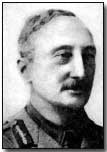Who's Who - Sir Hubert Gough
 Sir Hubert de la Poer Gough (1870-1963) was born in
Gurteen, Co. Wexford in 1870 and trained at Sandhurst. After joining
the 16th Lancers he served in the Boer War, relieving Ladysmith against
orders.
Sir Hubert de la Poer Gough (1870-1963) was born in
Gurteen, Co. Wexford in 1870 and trained at Sandhurst. After joining
the 16th Lancers he served in the Boer War, relieving Ladysmith against
orders.
In Ireland, as commander of the 3rd Cavalry Brigade at the Curragh in 1914, he opposed the use of force to impose Home Rule against the Ulster Volunteers.
Gough served as a cavalry officer during the First World War, leading a division of the British Expeditionary Force (BEF) on the Western Front during 1914-15. He became a corps commander in 1916, taking part in the Somme offensive later that year, and subsequently at Arras and Ypres.
Sir Douglas Haig, the Commander-in-Chief of the British forces, regarded Gough as one of his best officers, but faced criticism from others for his over-confident belief in the value of cavalry attacks.
As its commander Gough was blamed for the collapse of the Fifth Army during the great German push in March 1918 during Third Ypres, and was replaced by General Sir William Birdwood. He did not hold command again until after the war.
Gough retired as a full general in 1922, penning a self-vindication of Fifth Army in 1931. He was knighted in 1937.
Sir Hubert Gough died in 1963.
The "Blue Max" was a reference to the prestigious German Pour le Merite medal.
- Did you know?
